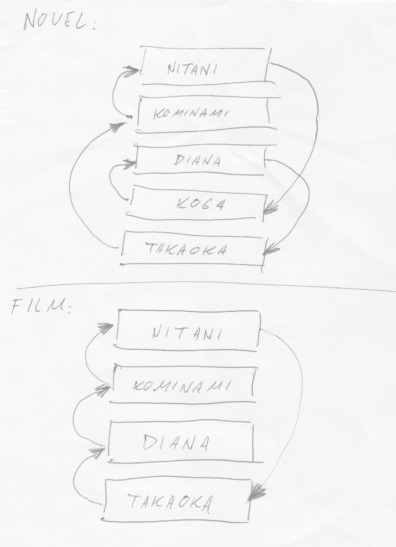 The cover. |
Ankoku Joshi (The Dark Maidens) is a bit of deductive storytelling written in 2013 by Akiyoshi Rikako, a mystery novelist with some stellar educational history. I stumbled upon its film adaptation directed by Yakumo Saiji, with a screenplay by Okada Mari (that’s how I found out about it) in October last year and randomly gave it a spin, to some amazing results. I had absolutely no idea what I’m getting into. I’d been wanting to read the original novel since that time, and finally decided I should quit putting that plan off when Vertical announced they would publish its English translation. It came out very recently, so go buy it. I, however, opted to buy the original Japanese novel instead. Which means I missed the cute illustrations. Oh well.
A catholic girls’ school in Japan, full of girly girls with filthy-rich parents, where pricey brand names and exclamations of “It’s French!” fly about all the time. There, the school’s literary circle is having a recital – each member was asked to write a story on one theme. The theme is… the recent death of the circle’s leader, Shiraishi Itsumi. After a short introduction, the event begins – every member gets to read out their story uninterrupted, in a very conventional, theatrical way. You’re in for a whole collection of fun, varied tales.
First up is Nitani Mirei, the poor girl who feels out of place in this school for highborn ladies. Itsumi reaches out to her and not only invites her to the circle, but also offers her a job tutoring her younger brother. The person she suspects of being Itsumi’s murderer is Koga Sonoko, who supposedly seduced the girl’s father.
Next, Kominami Akane, the club’s patissiere reads out her story. From it, we learn her family’s restaurant burned down in a fire, and that Itsumi has confided in her that Nitani’s been stealing things from her home. Although the first novella was overwhelmingly cheerful and positive, the one that follows it destroys that favorable impression. Not only does Kominami contradict her predecessor, it’s also increasingly obvious that Itsumi isn’t the sunny, benevolent central figure of the club. All of the members think highly of her, but you can start to see the truth about her through the cracks. Turns out Itsumi lies to her clubmates to sow some seeds of discord among them. If the blurb on the novel’s cover is to be believed, the book is all about figuring out who’s responsible for Itsumi’s death – it’s a whodunnit, where the reader needs to decide what facts to believe. A literary recital with all of the club members present might be a good way to find the answer to her death’s question. What if the killer is among them? It’s a specific kind of mystery, too. Ever seen Kurosawa’s film, Rashoumon? Ankoku Joshi is a Rashoumon clone – a narrative showing one tale from multiple perspectives, where every witness presents you his own, self-serving version of events. Ankoku Joshi made me see potential in this subgenre – maybe it’s the next big thing in nerdy culture?
Later, Diana the student from Bulgaria who knew Itsumi from her homeland accuses Takaoka Shiyo of killing Itsumi. Koga Sonoko, the candidate for a doctor, thinks Diana is a vampire. Takaoka Shiyo the teenage novelist believes Kominami poisoned Itsumi. At this point, it’s obvious the question to ask isn’t “which of them is the murderer” – the stories didn’t ellucidate the culprit and even calling the novel a mystery becomes questionable. This isn’t the end, though. The club’s acting leader, Sumikawa Sayuri proceeds to read a novella written by Itsumi herself, and everything becomes clear.
 Bunnies. How cute. |
Itsumi is a sadist wanting to be “the protagonist of life”. She created the literary circle to serve as a front covering her forbidden romance with a teacher – that Houjou-sensei who appeared in the background of the girls’ stories at times. To become the protagonist, she decided she needs sidekicks – characters of secondary importance who are completely dependent on her. To obtain those, she uses her wealthy father’s favorite tactics – to learn people’s dark secrets and use them to enslave her clubmates. Only Sayuri managed to remain on equal terms with her. We learn everything the girls have kept hidden. Itsumi builds herself a harem of sorts, and everything is wonderful for a while, until a certain event makes her entire world come down on her head… What follows is a twisty road to the ending to this story of a rich girl’s revenge for foiling her plans.
 I had to get my scanner from the closet, kansha shiro. |
Ankoku Joshi is a riveting piece of pop-lit – out of all the books in Japanese I’ve read it definitely reads the fastest, easiest and most pleasurable. An easy recommendation… is what I’d like to say, but NO. Don’t read it. Watch the film instead! It elevates the original novel into something much more polished and tight. The director did a great job, I recommend seeing Ankoku Joshi to everybody who likes to complain about Japanese cinema and its common problems. It’s incredible. It removes from the original what’s unneeded and adds a bit to create a neat, well-rounded 1h45m-long package. Koga Sonoko got completely written out of the story, or rather Takaoka and her got compressed into one entity. And that one shocking scene with Nitani and her old folks’ home adventures sure did remain in my memory – that was not in the novel. The chain formed by the suspected and the suspecting looks prettier in the movie, and that neatness can be felt even if you don’t write it down like I did. Anyway, watch this film. If my tweets and this blogpost doesn’t convince you, maybe the English edition of the novel will…
